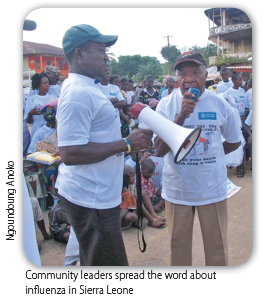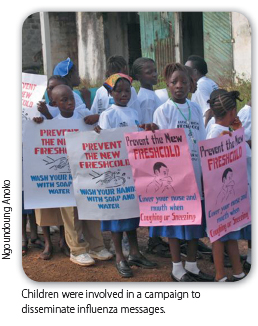NEWS
Spreading the word about seasonal influenza
Seasonal influenza communication campaigns around the world must be tailored to meet the needs of a country's people and culture. But what kind of campaigns work best and what are the hurdles? Ben Jones reports.
A group of small children in the low-income west African country of Sierra Leone stand in a line. Each is holding a poster with the slogan: 'Prevent the new fresh cold'.
This is a simple way of spreading a message about influenza. Messages can be communicated to the public in many forms, be it through the mass media, social networks or simple methods such as the one above, but that is not the issue. The question is which model works best for which country and why.
When you consider that, according to the World Health Organization (WHO), seasonal influenza is responsible for three to five million cases of severe illness and between 250000 and 500000 deaths each year, effective communication campaigns are of paramount importance. So, the key question health workers need to ask is how those working in the field can get these messages across.
Take, for example, Sierra Leone, one of the world's lowest-income countries, with an average health-care expenditure of only US$ 41 per person per year, was the subject of a WHO study in the autumn of 2009 that looked at the best way to get health messages across during the A(H1N1) influenza pandemic earlier that year.

The project which took the form of an awareness campaign, says Nahoko Shindo, a medical officer at WHO, posed several problems, most notably the need to ensure that the message reached its intended target: the local community.
"In Sierra Leone, we took two groups," she explains. "One group from George Brook a semi-urban setting around the capital, Freetown, and the other from Blama, a village in the east of the country. They have very different cultures and perceptions about the disease."
There were other challenges. "You can't really talk about the importance of hand-washing in areas where there is no safe water, so you really have to focus on respiratory hygiene," says Shindo. Respiratory hygiene includes putting your hand over your mouth when you sneeze or cough and not spitting near other people.
In the tropical climate of many countries in Africa, where only two seasons exist - 'dry' and 'rainy', the virus circulates all year round.
For many people in Sierra Leone, traditional healers are just as important as modern medicine. Most people cannot read or write so the influenza control campaign was run along simple lines. Town criers were used to spread the message about the 'new fresh cold' and local singers would perform songs about the virus in the local language in marketplaces or other areas where people gather.
Certain sections of society were targeted. For example, pregnant women were informed of the dangers of pandemic influenza by midwives who could, according to Shindo, "efficiently pass on the information to the targeted population".
To evaluate the campaign's success, the team working on the project developed two questionnaires. The first assessed the community's knowledge of influenza and randomly-selected members of the community responded. The second looked at community leaders' commitment to raise awareness after the end of the project. Community leaders involved in project implementation were interviewed. In each case, evaluators took down the verbal responses to the questions posed and translated them into English.
The results of the WHO study showed that, broadly speaking, grass-roots channels of communication involving community leaders were more effective than static methods, such as posters and mass media to get across messages about influenza.
Different countries communicate the need to combat seasonal influenza in different ways. Last year Brazil undertook its 13th seasonal influenza vaccination campaign, during which approximately 32.75 million doses of vaccine were administered. The campaign included a Day of National Mobilization on 30 April, and the health ministry extended the provision of these vaccines to pregnant women, children aged six months to two years and health-care workers; it had only been provided to indigenous people and health-care workers in previous years.
What the campaigns in Brazil and, more pertinently, in Sierra Leone show is that a country's lack of resources is not necessarily a barrier to a successful communication campaign.

In New Zealand, for example, the health ministry is working to increase vaccine uptake among the people most at risk of severe illness: the elderly, people with chronic conditions and pregnant women, by providing this free of charge.
New Zealand's 'Don't let the flu get you!' campaign aims to help health-care professionals reach out to these groups. Last year it provided them with a campaign pack including details about ordering vaccines, consent forms, clinical information and communication materials, such as posters and key campaign messages.
However, while it is important to get the general population to be aware of good practices when it comes to preventing seasonal influenza, there is another battle to fight: the need to protect health-care workers against seasonal influenza. Front-line health workers are in contact with patients on a daily basis so they can easily become infected and, in turn, pass on the virus to other patients. But these workers do not always get vaccinated. For example, in the United States of America (USA), influenza vaccination coverage for health-care workers stands at almost 63.5%, according to the Centers for Disease Control and Prevention.
An independent, not-for-profit organization, the Joint Commission, is hoping to address this problem. This body has produced a range of free educational materials that can be used on site at health-care facilities to inform workers about the benefits of seasonal influenza vaccination. Furthermore, a new standard to become effective on 7 July this year will require health-care facilities to offer vaccination against influenza to licensed independent practitioners and staff and to set incremental influenza vaccination goals, consistent with achieving the country's goal of 90% coverage of the population by 2020.
Robert Wise, a medical adviser at the Joint Commission, explains that while influenza vaccination coverage is too low at present, "it is moving in a positive direction", adding that the federal government, the US Centers for Disease Control and Prevention and other organizations in the country were working to this end.
Most vaccination campaigns though are designed to reach the general public. Bram Palache, Global Governments Affairs Director at Abbott Laboratories and the author of a study on vaccine provision and its links with national public health policies, which was published in the journal Vaccine in October 2011, says that health authorities have a role to play when it comes to conveying effective messages about seasonal influenza. He explains: "What we have identified is that awareness campaigns by health authorities are really one of the key drivers for vaccine uptake. They seems to be a key element for proper influenza control, and it is often not good enough or efficient enough."
A large part of the problem is that much discussion - and contention - about the effectiveness of different vaccines is going on within the scientific community. Such controversy filters down to the public via the media.
Influenza is a disease that affects people all over the world. As such, in a 2005 position paper WHO strongly emphasized the importance of raising public awareness about influenza and its complications, as well as the benefits of influenza vaccination.
Various studies have shown that influenza vaccine efficacy can range from 25% to 75%, depending on several factors, including a person's age, medical history and immune status. Scientists disagree over the efficacy of influenza vaccines, i.e. the ability of a vaccine to protect an individual against infection. For this reason, messages about what the public should do to prevent seasonal influenza - whatever form they take - have to be evidence-based, compelling, easy to understand and memorable.
However flu communication campaigns are delivered and whatever population groups they target - be they health-care workers, the elderly or young children - governments need to be involved.
As Palache says: "There needs to be a committed willingness to understand the need to protect people against influenza infections and the need to develop programmes for that." 
